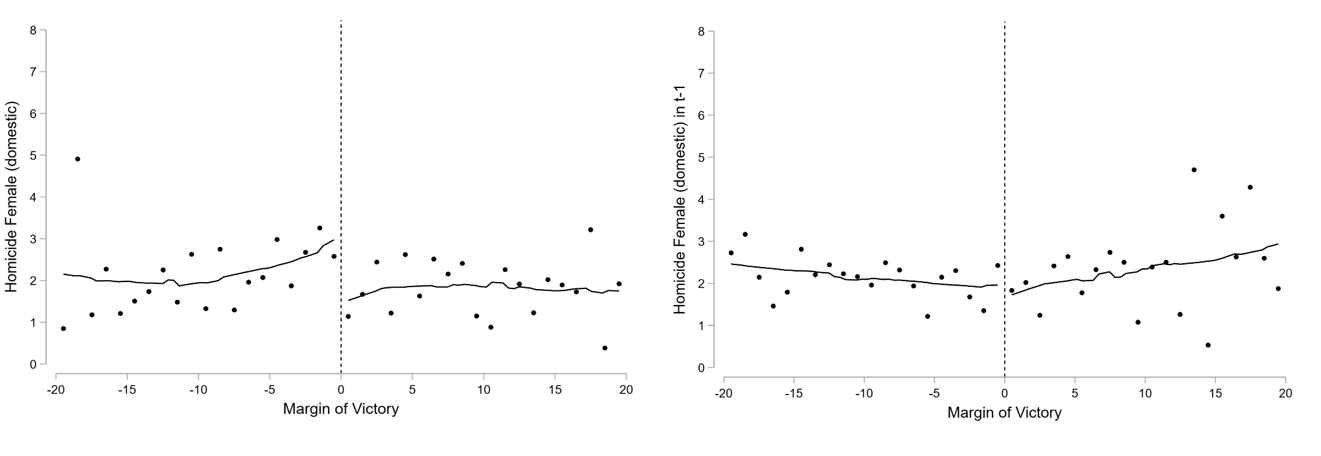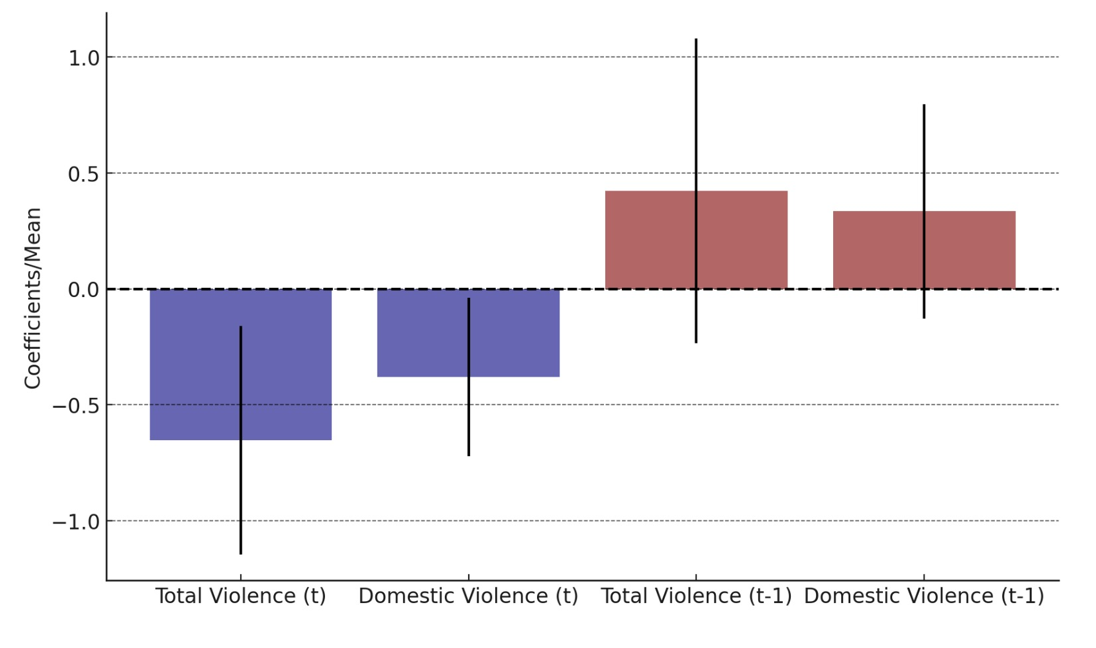
Greater female participation in political leadership roles is associated with a decline in violence against women in Brazil
In the last few decades, the presence of women in the political sphere has seen a remarkable increase globally, significantly influencing both social and economic policies (Hessami and da Fonseca 2020, Andreoli et al. 2021). Research, including empirical and experimental studies, has consistently shown that the empowerment and representation of women in politics lead to better policy decisions and outcomes, with a notable preference for social policies and interventions, and a marked reduction in corruption and bribery (Chattopadhyay and Duflo 2004, Brollo and Troiano 2016, Eckel and Grossman 2008). However, the specific impact of female representation on crimes, particularly those against women, remains underexplored.
This evidence gap is critical considering the distressing global statistic that one in three women experiences physical or sexual violence, impacting not only their well-being but also their ability to engage actively in society and politics. According to a 2017 report by the United Nations Office on Drugs and Crime (UNODC), 87,000 women were intentionally killed in 2017. The United Nations has set a sustainable development goal to eliminate all forms of violence against women and girls in both public and private spheres, highlighting it as a fundamental step towards achieving gender equality and empowering all women and girls. Violence against women, especially prevalent in low- and lower-middle-income countries, has led to the enactment of specific laws against femicide and gender-based violence.
Our latest study (Bochenkova et al. 2023) sheds light on the influence of women's political representation on domestic violence. We focus on whether the gender of policymakers can impact various forms of violence against women - including femicide, physical, psychological, and sexual violence - by examining elections in Brazilian municipalities where both male and female candidates competed. Utilizing a regression discontinuity (RD) design for elections held between 2004 and 2016, we provide causal evidence by comparing municipalities where female candidates narrowly won against male candidates to those where the reverse occurred. This approach allows us to explore the causal effect of female political leadership on combating violence against women.
Institutional background and data
Brazil, like many countries in Latin America, faces serious violence against women issues. Thanks to activists and political leaders pushing for change, there have been significant legal reforms. The landmark "Maria da Penha" Law in 2006 marked the start of tougher penalties for domestic violence and better support for victims, such as special police units and shelters. Efforts continued with the "Mulher, Viver sem Violência" program in 2013, improving policies for victims, and a 2015 law that specifically addressed femicide, highlighting it as an especially serious crime.
Despite these advancements, the prevalence of violence against women remains unchanged in many areas, with significant variations in violence levels across different municipalities. For example, data from 2018 showed that while 75% of municipalities reported no female homicides, those that did report such incidents had a wide range of homicide rates, illustrating the ongoing challenge in combating this violence.
To analyse the impact of female political representation on violence against women in Brazil, we assembled extensive datasets covering the period from 2000 to 2016. This included data on fatalities from external aggression in every municipality, which serves as a proxy for violence, addressing potential underreporting issues. We also utilised data from the Violence and Accidents Surveillance System (Sistema de Vigilância de Violências e Acidentes - VIVA), providing detailed information on various types of violence against women, including physical, psychological, sexual violence, and harassment, from 2009 to 2016. This data is complemented with records from the Brazilian Electoral Court (Tribunal Superior Eleitoral) on local elections from 2004 to 2016, detailing each candidate's vote share, gender, educational background, age, and party affiliation, allowing for a nuanced examination of the role of female political leadership in addressing violence against women.
Main Results
Our main findings are graphically presented in Figure 1, which plots the number of domestic homicides of women and girls aged 15–49 (per 100,000 individuals on average over an electoral term) against the female mayor’s margin of victory (a negative margin indicates a female candidate losing elections). The analysis covers female homicides for both the current electoral term (Panel A) and the term prior (Panel B). A clear discontinuity emerges at the threshold for domestic homicides in the current term, whereas such a discontinuity is absent for past-term outcomes. This pattern suggests a significant effect of female mayors on reducing domestic violence against women, evidenced by a substantial 50% decrease in domestic homicides over a four-year term compared to the mean of two per 100,000 population.
Figure 1: Effect on Women's Homicide
Panel A: Contemporaneous homicide Panel B: Prior-term homicides

Beyond the extreme cases of homicide, political representation by women also appears to significantly affect less severe forms of abusive behavior. Building on our initial findings, we further analyse the broader spectrum of violence against women, using the same methodological approach. Figure 2 presents our findings, showing the coefficient estimates (represented by bars) and the confidence intervals (depicted with black line segments) from a series of regressions. These regressions evaluate reported instances of violence, both in total and specifically domestic, across current and previous terms. In these analyses, the data consistently show that having a female mayor in Brazilian municipalities correlates with a marked decrease in violence against women aged 15 to 49. Over a four-year term, we observe approximately a 50% reduction in overall violence and a 30% reduction in domestic violence.
Figure 2: Effect on Violence against Women

To further validate our findings, we conducted placebo tests to explore if the observed effects extend to other related issues. These tests found no significant impact of female mayors on violent crimes against men, general mortality rates, motor vehicle accident death rates, or suicide rates among men and women, underscoring the targeted effectiveness of female leadership in restraining violence against women.
Conclusions
Our study indicates that greater female participation in political leadership roles is associated with a decline in violence against women. Determining the exact mechanisms behind this effect remains challenging. Pre-existing studies and our novel contributions hint at female mayors possibly prioritising policies that promote women's safety and rights. However, in our context, female mayors are not more likely than male mayors to implement specific protective measures like women's shelters or specialised police units – potentially because such policies are typically the responsibility of state authorities. Further research is needed to understand the exact processes through which female political leadership impacts violence against women.
References
Andreoli, F, E Manzoni, and M Margotti (2022), "Women at work: Gender quotas, municipal elections and local spending." European Journal of Political Economy 75: 102175.
Bochenkova, A, P Buonanno, and S Galletta (2023), "Fighting violence against women: The role of female political representation." Journal of Development Economics 164: 103140.
Brollo, F, and U Troiano (2016), "What happens when a woman wins an election? Evidence from close races in Brazil." Journal of Development Economics 122: 28-45.
Chattopadhyay, R, and E Duflo (2004) "Women as policy makers: Evidence from a randomized policy experiment in India." Econometrica 72(5): 1409-1443.
Eckel, C C, and P J Grossman (2008), "Differences in the economic decisions of men and women: Experimental evidence." Handbook of experimental economics results 1: 509-519.
Hessami, Z, and M Lopes da Fonseca (2020), "Female political representation and substantive effects on policies: A literature review." European Journal of Political Economy 63: 101896.



